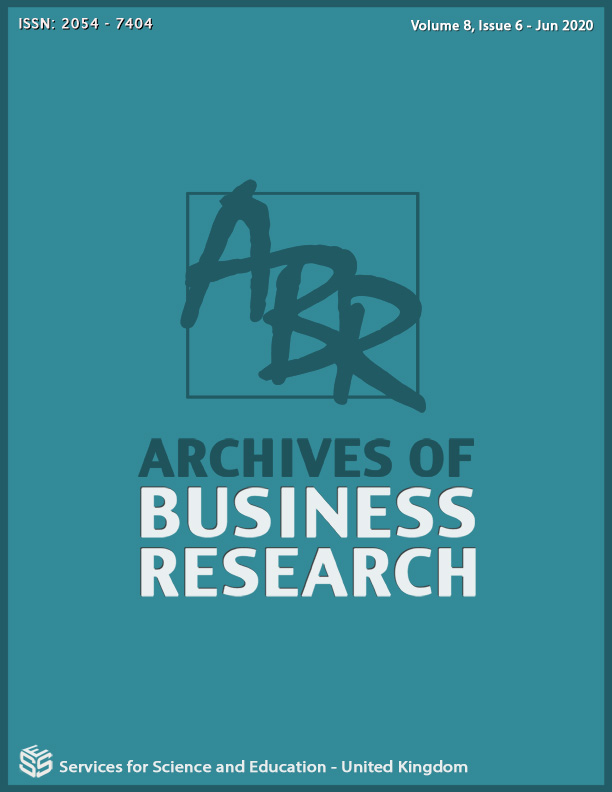Analysis on the influencing factors of spatial correlation of haze pollution in North China
Experience research based on QAP analysis
DOI:
https://doi.org/10.14738/abr.86.8365Keywords:
Northern Region; Haze Pollution; Spatial Correlation; QAPAbstract
Based on the AQI daily data of Northern China from January 1, 2016 to December 31, 2018, this paper uses nonlinear Granger causality test technology to identify the spatial correlation of haze pollution, and from the perspective of relational data, adopt Quadratic Assignment Procedure (QAP) to investigate the influencing factors of the spatial correlation of haze pollution in northern China. This study finds that:(1) QAP correlation analysis shows that geographical distance matrix, difference in the development level of the tertiary industry and difference in the green space area of urban construction are correlated with haze pollution. (2) QAP regression analysis results show that geographic distance matrix, economic development level and environmental regulation level can explain why the adjustment factor of spatial correlation of haze pollution is 2.6%. The influence of geographical distance matrix on the spatial correlation network of haze pollution within the range of 0~300km has passed the significance test, which indicates that haze pollution has broken through the geographical proximity effect, and more distant cities also have spatial correlation of haze pollution.
References
[2]Gan Chunhui,Zheng Ruogu and Yu Dianfan, 2011. An Empirical Study on the Effects of Industrial Structure on Economic Growth and Fluctuations in China. Economic Research Journal 5, 4-16.
[3]Krackhardt D. Predicting with Networks: Nonparametric Multiple Regression Analysis of Dyadic Data[J]. Social networks, 1988, 10(4): 359-381.
[4]Li Jie, Teng Li, 2014. The Time-space Characteristics and Determinants of Urban Air Quality in Pearl River Delta. Urban Insight 5, 85-95.
[5]Li Jing, Chen Wei, Wan Guanghua, etc., 2014. Study on the Spatial Correlation and Explanation of Regional Economic Growth in China— Based on Analytic Network Process. Economic Research Journal 11, 4-16.
[6]Liu Haimeng, Fang Chuanglin, Huang Jiejun,etc., 2018.The spatial-temporal characteristics and influencing factors of air pollution in Beijing-Tianjin- Hebei urban agglomeration. Acta Geographica Sinica 73(1), 177-191.
[7]Liu Huajun, Du Guangjie, 2018. Research on Spatial Correlation of Haze Pollution in China. Statistical Research v.35; No.319(4):5-17.
[8]Liu Huajun, Peng Ying, Pei Yanfeng, Jia Wenxing, 2018. Has the Total Factor Productivity Become the Determinant of Regional Economic Disparity in China Journal of Finance and Economics. Journal of Finance and Economics v.44; No.439(6):51-64.
[9]Liu Huajun, Lei Mingyu, 2018. The Dilemma of the Regional Collaborative Governance of Haze Pollution and its Solution Ideas in China, China Population Resources and Environment 10, 88-95.
[10]Liu Huajun, Liu Chuanming, 2016. Air Pollution's Nonlinear Transmission among Cities and Its Co-Movement Network in Jing-Jin-Ji Region. Chinese Journal of Population Science 2, 84-95.
[11]Pan Huifeng, Wang Xin, Zhang Shuyu, 2015. Severe Haze Pollution Spillover Effect: Evidence from Beijing-Tianjin-Hebei Region. Scientific Decision 2, 1-15.
[12]Ren Xia, Xue Bing, Zhang Lin, etc., 2013. Spatiotemporal variations of Air Pollution Index in China’s Megacities. Chinese Journal of Ecology 10, 2788-2796.
[13]Van Donkelaar, A., Martin, R.V., Brauer, M., Kahn, R., Levy, R., Verduzco, C., & Villeneuve, P. J., 2010, “Global Estimates of Ambient Fine Particulate Matter Concentrations from Satellite-based Aerosol Optical Depth: Development and Application”, Environmental Health Perspectives, 118(6), 847-855.
[14]Yang, G., Wang, Y., Zeng, Y., et al., 2013, “Rapid health Transition in China, 1990–2010: Findings from the Global Burden of Disease Study 2010”, The lancet, 381(9882), 1987-2015.
[15]Yang, N., Ji, D., & Li, S., 2015, “The Application of Pearson Correlational Analysis Method in Air Quality Analysis of Beijing-Tianjin-Hebei Region”, Agricultural Science & Technology, 16(3), 590-593.
[16]Yang Qian, Wang Hongru, Liu Huajun, 2016. Has the regional air pollution joint defense joint control achieved the expected results?——Evidence from the provincial capital of Shandong Province. Economic Research Journal 4, 3-21.






